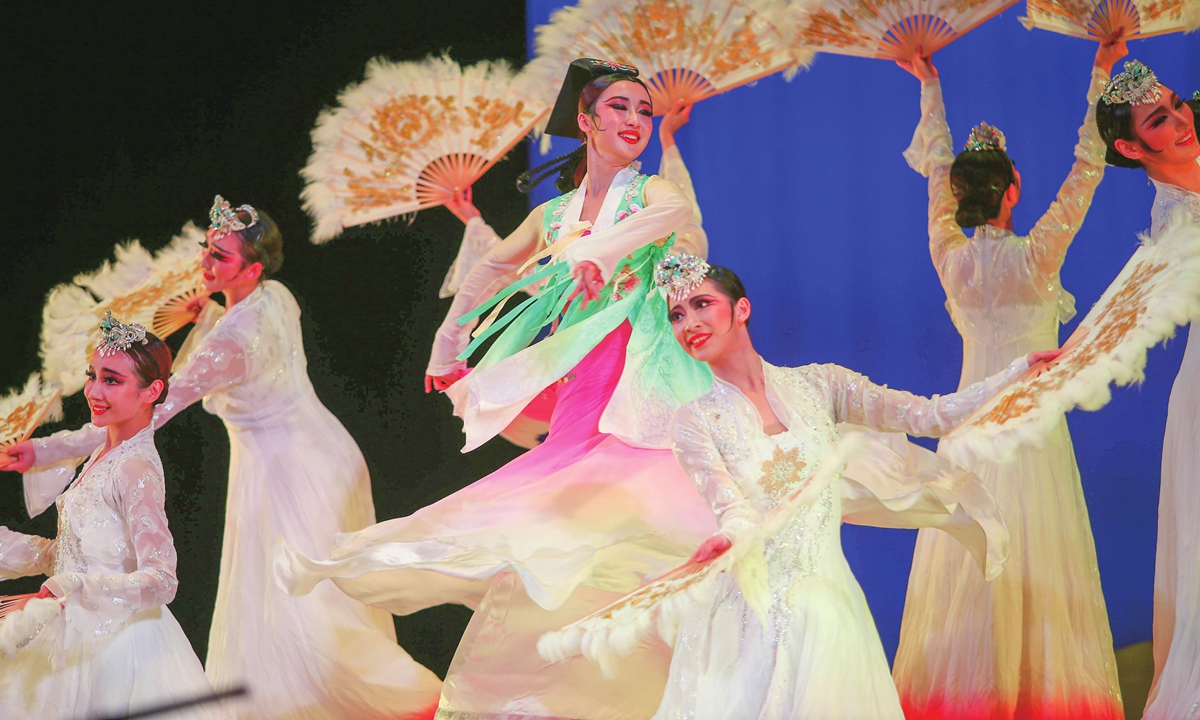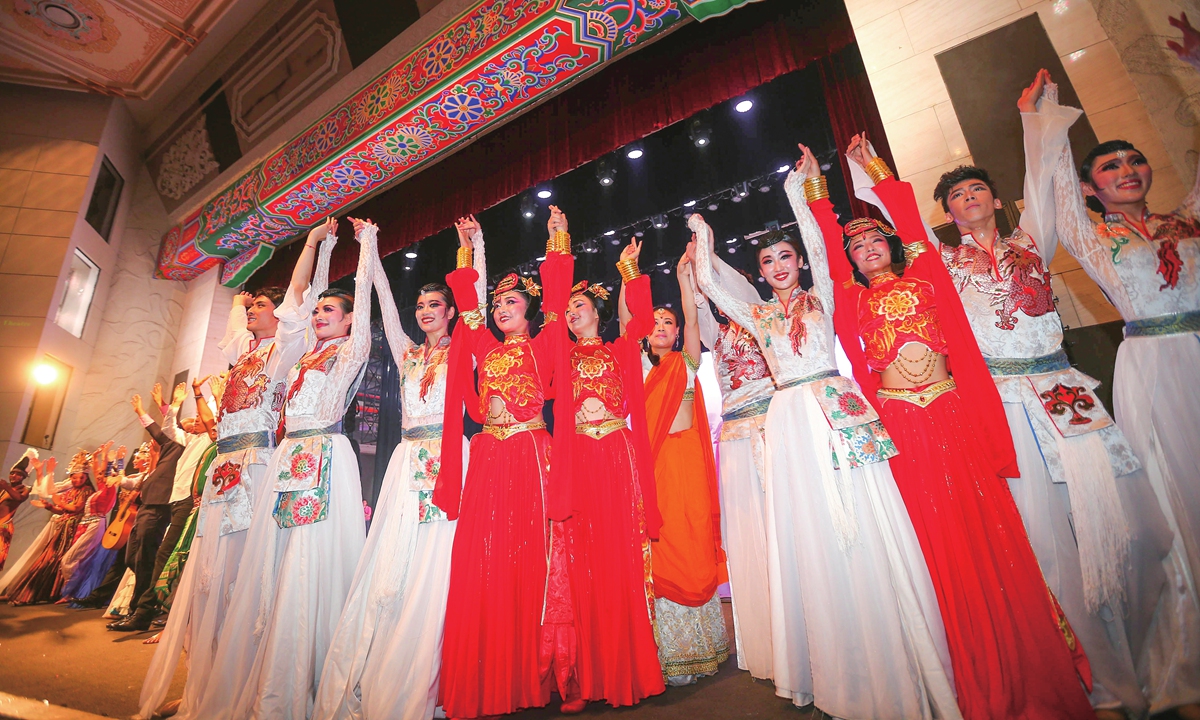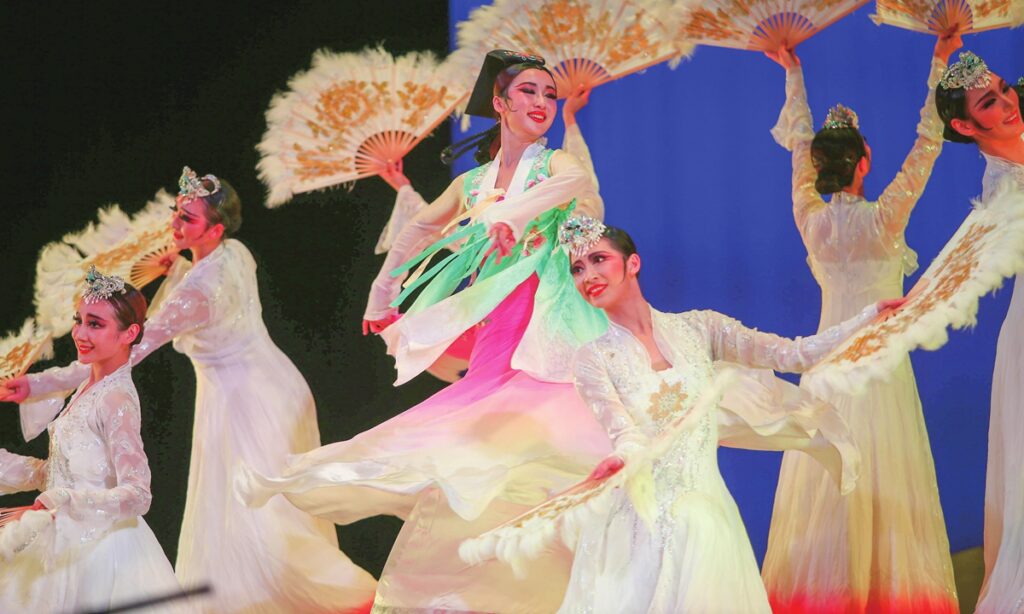Chinese people believe that letters are as valuable as gold. For thousands of years, letters, across mountains and oceans, have been delivering the writers’ sentiments, friendship, and expectations.
Xi Jinping, general secretary of the Communist Party of China (CPC) Central Committee, has managed to find time to reply to some letters from different parts of the society and the world despite his busy work schedule. Xi is also Chinese president and chairman of the Central Military Commission.
Through his letters, Xi has corresponded with international friends from all walks of life on numerous occasions. His letters have also been delivered to “home” senders such as Chinese experts and artists. The Global Times traced and contacted some of the addressees of Xi’s letters to hear the inspiring stories behind the letters.
This installment tells the story of letters exchanged between Xi and artist representatives from the China Oriental Performing Arts Group (COPAG).
“Cultural envoy” was what Xi has referred the COPAG in his letter. The title was a given laurel from Xi that encourages the art group to deliver more Chinese cultural performances to world audiences in the year of 2023, including a folk musical Huang Tu Gao Ge that Jing Xiaoyong, head of COPAG, exclusively revealed to the Global Times.

A dance performance themed the Silk Road is put on by China Oriental Performing Arts Group in Xi’an, Northwest China’s Shaanxi Province in September 2014. Photo: VCG
A letter to Chinese artists
In a reply dated December 24, 2022 to a letter coauthored by 10 artist representatives from the COPAG, Chinese President Xi Jinping encouraged them to continue telling good Chinese stories by “singing for the times and dancing for the people.”
“Generations of artists stay true to their original aspirations and keep their missions in mind. They sing for the times and dance for the people, demonstrating their missions and responsibilities as artists,” Xi noted in his reply letter.
The COPAG’s group letter to Xi was signed by veteran artists like 87-year-old Chinese composer Gu Jianfen, as well as young artists such as Xu Mingcong, a folk singer who was born in 1996 and calls herself a “newcomer” to the decades-old art group.
Xu told the Global Times that she was excited when the group received Xi’s reply letter. Xi’s words encouraging the artists to show the “vigor of the Chinese people” in their performances motivated her the most.
“I hope that you will fully demonstrate the mainstream values of the new era and the vigor of the Chinese people in your singing and dancing performances, so as to make new contributions to the prosperity of performing arts, to building cultural confidence and strength, and to developing China into a socialist country with strong culture,” Xi noted in his letter.
“It reminds me that our creativity and performances cannot be separated from people; they represent our Chinese spirit,” Xu told the Global Times.
“His words made me see the meaning of being a dancer. A dancer’s power maybe little, but the mission behind it is tremendous,” said Meng Qingyang, COPAG’s young dancer.
In order to infuse the Chinese spirit into art productions, Jing Xiaoyong, Party chief and chairman of COPAG, told the Global Times that in the last decade, all their shows have been conceived around themes of “traditional Chinese culture,” “red culture,” and China’s “advanced socialist culture.”
With such clear goals, performances like the Poverty alleviation On the Road, a folk dance drama, were created in 2020 to show how China’s poverty alleviation efforts are driving social development forward.
Huang Tu Gao Ge, another folk musical that Jing revealed exclusively to the Global Times, will also be released in 2023. It gathers inspiration from Northern Chinese folk songs such as from the Shaanxi and Shanxi provinces to depict the development history of the Communist Party of China (CPC) through the voices of numerous Chinese art workers such as dancers and literati.
“We want our performances to show how the Chinese spirits has advanced with the times,” Jing said, quoting Xi’s words in the reply letter hoping Chinese artists to “uphold fundamental principles and break new ground.”
“I hope that you will further study, publicize, and implement the spirit of the 20th National Congress of the Communist Party of China, adhere to a people-centered orientation in creating artworks, seek integrity and high standard in your pursuit of art, uphold fundamental principles, and break new ground.” Xi stressed in his letter.
Creativity rooted in tradition
In 2021, the COPAG indeed promoted a ground-breaking dance drama called The Journey of a Legendary Landscape Painting which remained popular even into 2022, as evidenced by a total of 200 fully booked out shows held all over the country.
The dance, which took inspirations from China’s classic art of the Ten Thousand Li of Rivers and Mountains, has become a prominent show that defines the “China chic” trend, embracing mostly the young audiences and encouraging them to fall in love with Chinese cultural classics.
Qu Dong, a theater studies expert in Shanghai, told the Global Times that the drama was a “phenomenal production.” It sheds a light on Chinese performance arts’ future development of turning the “traditions into contemporary cultural IP.”
Following the Ten Thousand Li of Rivers and Mountains, COPAG, the creator of the show, has seized on the momentum to carry on producing new projects such as the 2023 dance drama Dong Po.

Performers from the China Oriental Performing Arts Group greet the audience after a performance in September 2014. Photo: VCG
The dance was inspired by the true life story of great Chinese poet Su Shi in Song Dynasty (960-1279). Jing told the Global Times that in the show, the ancient poet’s admirable characters reflect the contemporary image of the Chinese people.
“Su had suffered some setbacks in his life but none of them changed his patriotism, his optimism, and also his open-minded attitudes to life,” Jing said.
“His passion and courage also reflect the amiable, lovely, and respectable images of Chinese people of today.”
Xiong Jinbo, a playwright of theater performance, in Wuhan, capital of Central China’s Hubei Province, told the Global Times that transforming such true-history-based stories into contemporary stage productions has to maintain the Chinese cultural spirit at its core.
“No matter how much diversity we bring into our creative performances, Chinese cultural confidence still underpins them all,” Jing said.
‘Cultural card’ of New China
Xi’s letter to the COPAG was timely, as the year 2022 marked the 70th and 60th anniversaries of COPAG’s two predecessors, the Central Song and Dance Troupes and the Oriental Song and Dance Troupe.
“Over the years, you have conscientiously implemented the Party’s principles and policies on literature and art, produced many excellent works, made positive contributions to the prosperity and development of the performing arts, and to cultural exchanges with foreign countries, and become an important ‘cultural envoy’ and a bright ‘cultural card’ of New China,” Xi noted in his letter.
As far back as 1962, the Group’s predecessor, the Oriental Song and Dance Troupe, had been undertaking a cultural diplomatic role, performing abroad in mainly Asian, African, and Latin American countries.
The predecessors of COPAG told historical stories.
Founded in 1962, the Oriental Song and Dance Troupe was the first Chinese national-level performance group appointed by the then Chinese premier Zhou Enlai. Among Chinese people who were born after the 1960s, the group was always a “golden art brand” that represented China’s best art to be displayed overseas.
The Central Song and Dance Troupe, another predecessor to COPAG, marks the first performance arts group established after the founding of People’s Republic of China in 1949.
Conducive to China’s increased international discourse power and its insightful policies such as the Belt and Road Initiative (BRI) that was proposed 10 years ago, the COPAG was able to promote Chinese arts in more countries such as New Zealand, Spain, Australia and the US.
Drama dances such as Guo Se (lit: the color of China) was debuted in New York in 2019, gathering more than 900 people in one show. The Chinese stories, performed in Wellington that same year, shows how the soft power of art can engage Westerners to see the real beauty of China.
Jing told the Global Times that over the years, COPAG’s artists have visited almost 100 countries and regions around the world.
“The time I performed in the Republic of Benin, I felt high expectations from the local audiences to see us perform [Chinese arts] on stage. Although there may be cultural differences, you could feel their respect and admiration for Chinese culture,” Meng Qingyang, the lead dancer of The Journey of a Legendary Landscape Painting, said while sharing her experiences with the Global Times.
Cultural communication between China and the rest of the world never runs one way.
Jing told the Global Times that in 2023, the COPAG will start to arrange “overseas artists collaborations” while aiming at engaging foreign artists to perform in Chinese shows. Another new show about how Chinese enterprises collaborate with Southeast Asian countries such as Laos is also underway, Jing told the Global Times.
The COPAG adheres to what Xi has noted in the reply letter, to be “upholding fundamental principles, and breaking new ground.” Jing told the Global Times that aside from touring abroad, the art group also seeks for “channel innovation” to expand their overseas art communication territory.
On YouTube, the popular Western online video sharing platform, the COPAG’s official account has been followed by more than 11,0000 fans. It shares interesting content not only including behind stage footages, but also reaction video content featuring trending youtubers like the British Jack.
“The category of ‘reaction video’ is a new way to play with ‘cultural difference.’ Instead of avoiding the culture shock, saying what you really feel about a culture is a new way to bond,” Jiang Yuting, a social media expert, told the Global Times.
At the entrance of the COPAG’s office building, Xi’s reply letter has been printed on the wall alongside photos showing his previous visit to the Chinese art group.
(Global Times)




